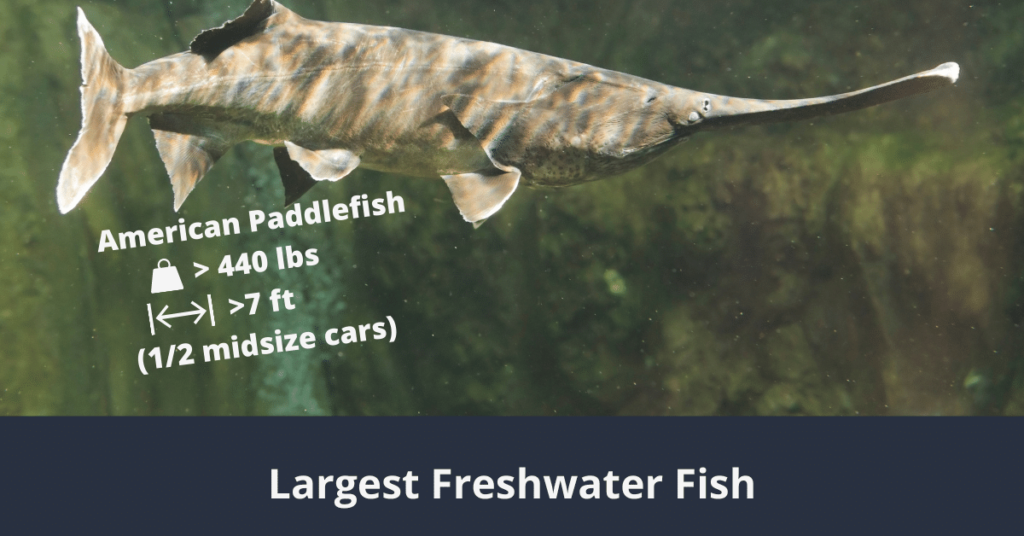Fish have played a pivotal commercial role in rivers, oceans, ponds, and other bodies of water. Not only do fish make a delicious, protein-rich meal, but they also supply oils and other useful hides. Those who are not hunting, these massive creatures are fun to watch and enjoy recreationally.
In this article, we discuss some of the most captivating, largest freshwater fish you will find. We provide a top 10 list of the largest freshwater fish including individual top weights and lengths, their standard diet, and where you can find these compelling organisms. We also highlight what makes these fish unique when it comes to hunting and surviving.
(You might be interested in reading about the Largest Fish in the Ocean)
Everything you will learn here
Top 10 Largest Freshwater Fish
| Largest Freshwater Fish # | Name of Fish | Length in Feet |
|---|---|---|
| 10 | Nile Perch | 6 ft. (1.83 m) |
| 9 | Taimen | 6 ft. (1.83 m) |
| 8 | Ocean Sunfish | 8 ft. (2.44 m) |
| 7 | Alligator Gar | 8-10 ft. (2.44 m – 3.04 m) |
| 6 | Arapaima | 9-10 ft. (2.74 m – 3.04 m) |
| 5 | American Paddlefish | 10 ft. (3.04 m) |
| 4 | Mekong Giant Catfish | 10-12 ft. (3.04 m – 3.65 m) |
| 3 | Bull Shark | 11-13 ft. (3,35 m- 3.96 m) |
| 2 | Giant Freshwater Stingray | 15 ft. (4.57 m) across |
| 1 | Beluga Sturgeon | 20-24 ft. (6.10m – 7.32 m) |
10. Nile Perch
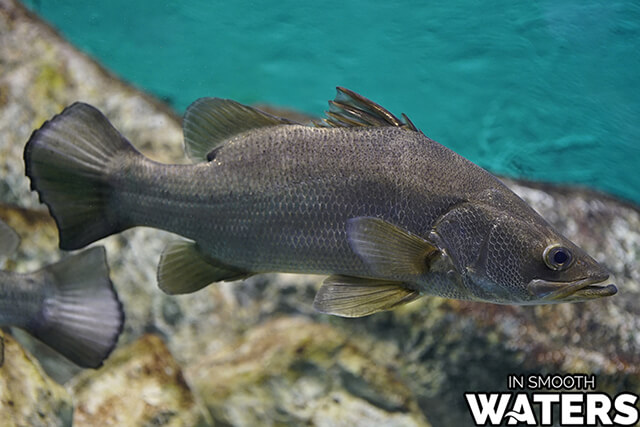
The Nile Perch, based in Africa, measures up to 6 feet (1.83 meters) in length and 500 pounds (ca. 227 kg) in weight. You will most likely find this fish in the river basins of Senegal, Chad, Volta, Nile, and the Congo. The size of this fish usually causes environmental issues. Since it has been introduced to other waters, the native fish populations decrease. The Nile Perch is recognized as one of the world’s worst invasive species.
Although it can live in most freshwater bodies, the Nile Perch also likes warmer tropical waters. The females are usually larger than the males, but they both utilize their size for hunting down prey like mollusks, crustaceans, insects, and other fish. These fish typically breed between March and June, and a female can produce up to 9 million offspring each year.
9. Taimen
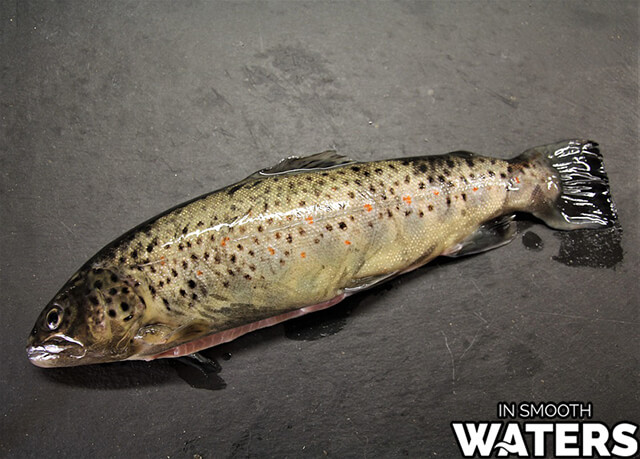
The Taimen is highlighted as the most massive salmonid family member, which consists of salmon and trout. These fish can measure as long as 6 feet (1.83 m) and weigh up to 230 pounds (ca. 104 kg). You can recognize a Taimen by seeing its streamlined body and green-gray head. As you move down toward the tail, it turns reddish-brown. Their undersides are white, and their fins are usually dark red.
Much like the Arapaima, the Taimen utilizes its massive size to be a fierce predator, and it can jump out of the water for a surprise attack. These fish typically feed on other fish, but they also indulge in ducks, rats, and bats. Taimens, unlike their other salmonids, live in freshwater and fast-flowing rivers for most of their lives. When they want to reproduce, they temporarily settle upstream in tributaries.
8. Ocean Sunfish
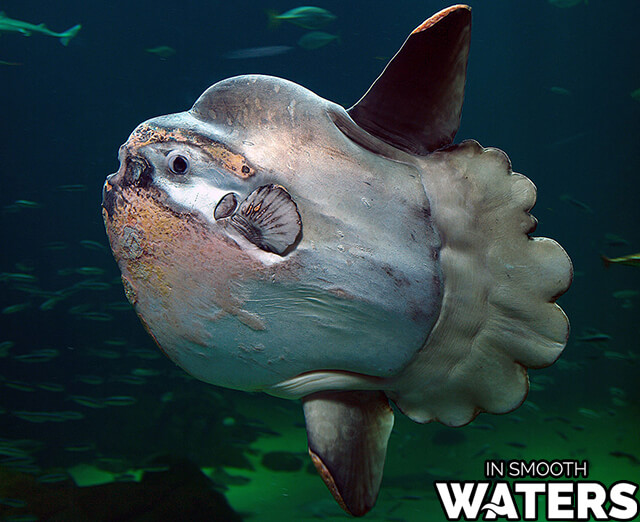
The Ocean Sunfish is a giant freshwater creature, measuring up to 11 feet (3.35 m) in length and up to 2,500 pounds (1.13 t). Although it is a massive fish, it only looks like half a fish. Also called mola, these fish are usually found in tropical and temperate oceans around the globe. They love to reside towards the top surface of the water to bask in the sun. They also contain massive dorsal finds and beak-like teeth.
Because these fish are the most massive out of the bony fish, they are usually clumsy swimmers. They steer with their clavus and maneuver with their larger anal and dorsal fins. The Ocean Sunfish often feast on jellyfish, but they will also focus on algae and zooplankton.
7. Alligator Gar
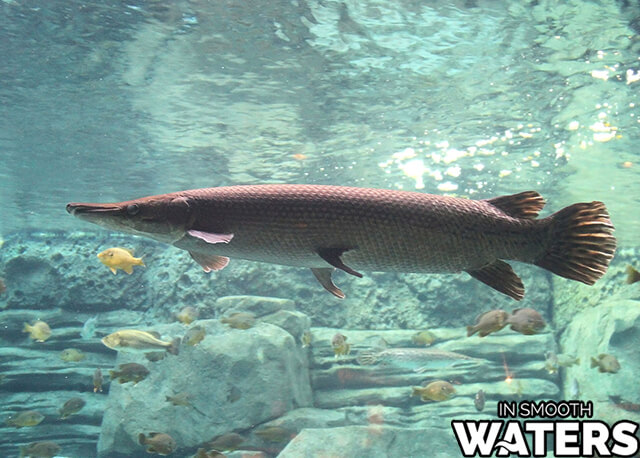
Alligator gar are the most significant apex hunters in the Mississippi River. These voracious large freshwater fish can weigh up to 302 pounds (ca. 137 kg), and they can measure up to 80 inches (ca. 2 m) in length. The diet of an Alligator gar consists of turtles, blue crabs, waterfowl, or other small mammals and birds. These types of fish prefer larger rivers that have a massive flood plain.
Alligator gar gather in groups next to specific locations both before and after their spawning periods. Depending on the geographic area and environmental conditions, the egg hatching process takes anywhere between 48 and 72 hours.
Alligator gar are usually a commercial fish that gets hunted in the southern states of the U.S. Over the last 50 years, the Alligator gar population has shrunk. They are not thought of as a recreational fish, except in the Rio Grande River and Alabama.
6. Arapaima
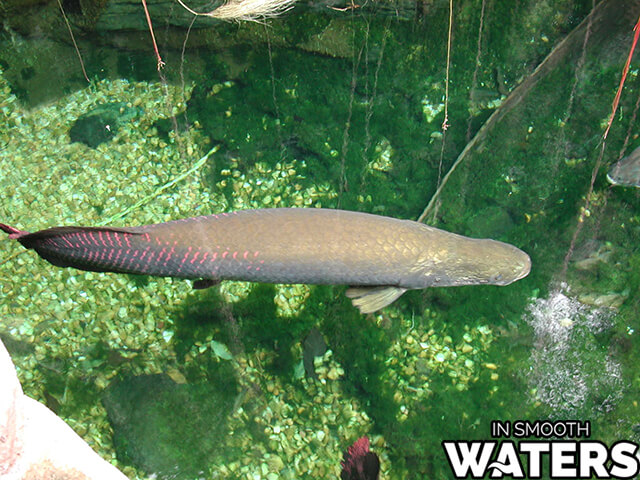
The Arapaima, an air-breathing fish, inhabits the Amazon Basin in South America and closes by swamps and lakes. This air-breathing fish can reach up to 15 feet in length and up to 440 pounds (ca. 200 kg) in weight. These fish are also characterized by green-copper-colored heads, scaly bodies, and perched mouths. They also have a beautiful dorsal fin that spans their back toward their more giant, red tails.
The Arapaima uses its powerful gulper feeding strategy to establish a vacuum that sucks up nearby fish and other food objects. Most of an Arapaima’s diet consists of fish, but it also eats seeds, insects, and fruits. These versatile hunters can also jump out of the river to snag lizards, birds, and even primates hanging in the lower trees.
5. American Paddlefish

The American Paddlefish has lived in the freshwater of the Mississippi since over 65 million years ago. You will usually find these fish in more extensive, slower flowing tributaries and rivers. The more massive specimens of these fish can weigh up to 440 pounds (ca. 200 kg), and they can reach up to 8 feet (2.44 m) .
After the peak of commercial harvest use for Paddlefish in 1900, these fish became endangered or threatened species within a wide range of states. Although the Paddlefish is native to the Mississippi River, they are a migratory species that can travel up to 2000 miles through rivers. These fish are also versatile and can move smoothly through brackish water, which contains a freshwater-saltwater mix.
4. Mekong Giant Catfish
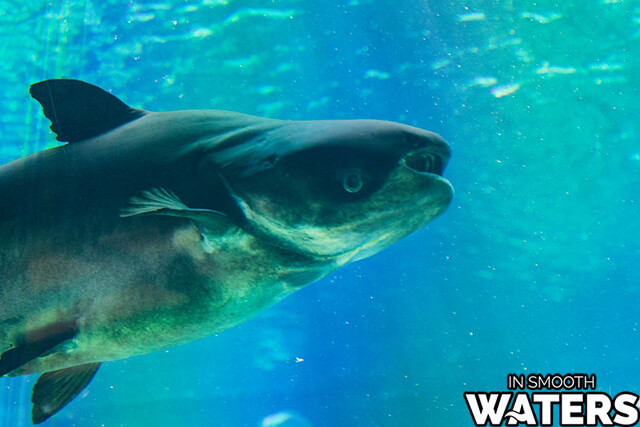
Based out of Northern Thailand, the Mekong giant catfish is structured at a lengthy 9 feet (ca. 274 cm) in length and measures up to 646 pounds (ca. 293 kg) in weight. Even though it is a massive fish, the Mekong catfish is closing in on extinction because the numbers in its native Mekong River continue to decrease.
The color of the Mekong catfish is underwhelming with its gray-white color. It also has low-set eyes and a lack of whiskers and teeth. Toward the beginning of their lives, these fish feast on zooplankton and are cannibalistic. But as soon as they reach one year in age, they mostly eat algae and plants.
Not only is the Mekong catfish a more massive fish, but its rate of growth makes it a differential nominee for this list. Some fish can reach a weight of 440 pounds in just under six years. Although the Mekong numbers are decreasing, these fish can live a full life of up to 60 years.
(You can read about the other Fish with Longest Lifespan)
3. Bull Shark

The aggressive Bull Shark, usually located in higher-populated areas, is measured between 7 and 11.5 (2.13 – 3.50 m) feet in length and 200 to 500 pounds (ca. 91-227 kg) in weight. This fish gets its name from its blunt, shorter snout. They are also fierce, pugnacious competitors and headbutt their prey before they begin to attack. You will usually find the Bull Shark near tropical shores, freshwater and brackish areas, and even tributaries and rivers.
Combined with its massive weight and length, the Bull Shark is recognized as one of the more dangerous sharks in the world. Their longer pectoral fins and their thick bodies make them a tough fish to encounter in many of these waters. Over the last few decades, the length and overall number of the Bull Shark have declined on average, because people usually hunt for their hides, meat, and oils.
(You might be interested in reading about the other Most Dangerous Freshwater Fish)
2. Giant Freshwater Stingray
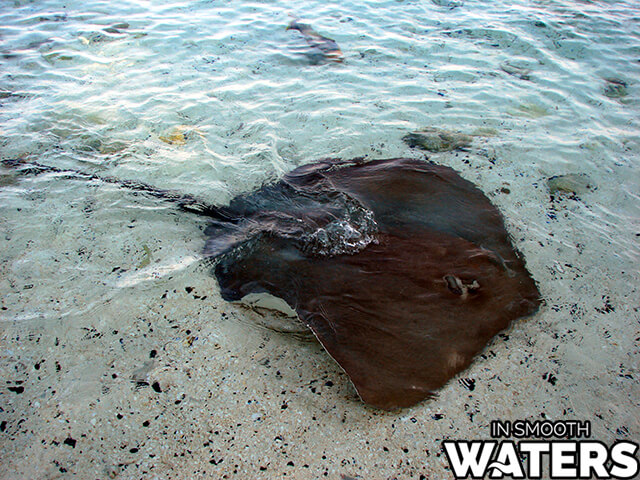
The Giant Freshwater Stingray is considered one of the largest freshwater fish because of its towering long 8-foot length and heavy 1,300 pounds (ca. 590 kg) weight. The total population number and location are often a mystery, but you can recognize these fish by their brown-gray color, full and flat body top, and longer whippy tails. You will usually find them in rivers in Thailand, Malaysia, Indonesia, and Cambodia.
These Stingrays do not usually attack humans, but they hunt prey like crabs and clams. They have a sensor near their mouth, which allows them to detect and track other organisms via an electrical field. A significant reason why there is less information on these fish is that they typically stay hidden toward the bottom of rivers.
1. Beluga Sturgeon: The largest freshwater fish in the world

The Beluga Sturgeon might be the world’s largest freshwater. The fish weighs a gigantic 3,500 pounds (1.59 t) and measures up to 24 feet (ca. 7 m) in length. These fish have dinosaur bodies that align with their long-lasting lineage of up to 200 million years old.
The Beluga Sturgeon is a coveted fish because it produces the most quality caviar on earth. Some larger Beluga carries hundreds of pounds of caviar, worth up to $3500 per pound. These fish provide delicious food with their eggs, but it is also one of the most abundant predatory fishes in the world. The Beluga Sturgeon protects itself with durable, bony plates and asymmetrical tails that resemble that of a shark.
These fish also have a longer barbell snout to sniff out its prey. Although this fish looks intimidating at first glance, it is considered harmless and stays away from people as much as possible.
A female Sturgeon can live anywhere from 80 to 150 years, which makes itamong the longest living Fish.
Top 10 Biggest Freshwater Fish in the world
If you sort the freshwater fish by weight the ranking changes, but one constant remains: The Beluga Sturgeon ranks as the largest freshwater fish by size and the biggest one by weight.
| Biggest Freshwater Fish # | Name of Fish | Weight |
|---|---|---|
| 10 | Bull Shark | 200 to 500 pounds (ca. 91-227 kg) |
| 9 | Taimen | 230 pounds (ca. 104 kg) |
| 8 | Alligator Gar | 302 pounds (ca. 137 kg) |
| 7 | American Paddlefish | 440 pounds (ca. 200 kg) |
| 6 | Arapaima | 440 pounds (ca. 200 kg) |
| 5 | Nile Perch | 500 pounds (ca. 227 kg) |
| 4 | Mekong Giant Catfish | 646 pounds (ca. 293 kg) |
| 3 | Giant Freshwater Stingray | 1,300 pounds (ca. 590 kg) |
| 2 | Ocean Sunfish | 2,500 pounds (1.13 t) |
| 1 | Beluga Sturgeon | 3,500 pounds (1.59 t) |
Related:
Biggest Fish in the Ocean List: 10 Astounding (and Unknown?) Creatures
Other Freshwater Giants that don’t belong to the Top 10 biggest freshwater fish
Not all largest freshwater fish could make the list of the op 10 biggest freshwater fish. But here are some of the honorable mentions:
- Reef Manta Ray
- Kaluga Sturgeon
- Tiger Shark
- Whale Shark
- Electric Eel
Top 10 largest freshwater fish: Wrap Up
There are many unique fish that make up the top 10 biggest freshwater fish lists. When it comes to dieting, reproduction, and survival, they are all unique in their way. But one thing is consistent across the board: they each use their size to establish dominance and safety in whatever waters they inhabit. The Beluga Sturgeon is the largest and biggest predator of freshwater bodies which measures up to 24 feet (ca. 7 m) and 3,500 pounds (1,59t).

